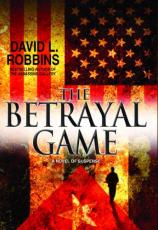The Betrayal Game
Review
The Betrayal Game
Talk
about timing. David L. Robbins has it, and not just in the literary
sense. Robbins lays down his new book, THE BETRAYAL GAME ---
dealing with a plot to assassinate Fidel Castro in 1961 --- and
guess who retires within a couple of weeks after it hits the
shelves? If there is any connection between Castro’s
abdication of his dictatorship and this fine novel, arguably it
would be that the bearded one decided he wanted some time off to
read this riveting work.
In his introduction, Robbins describes THE BETRAYAL GAME as
“thinly fictionalized fact.” Indeed, it centers on a
plot to end Castro’s life on the eve of a clandestine
invasion by a U.S.-backed force. Though it is not conclusively
documented, evidence would indicate that the coordinated
assassination attempt was a joint effort conducted by the CIA and
certain members of organized crime syndicates, the latter motivated
by the nationalization of mob-owned businesses and industries in
Cuba following Castro’s takeover.
Robbins drops Mikhal Lammeck, professor of history and retired
special forces instructor, into this cauldron as observer and
historical force. Lammeck’s welcome return --- he was first
introduced in THE ASSASSIN’S GALLERY --- is fraught with
danger, as he finds himself caught between opposing forces in
post-revolutionary Cuba. First approached by (Pablo de Santana)
Johan (Guerrero), the pleasant but enigmatic captain of
Castro’s security force, then by Bud Calendar, a CIA agent
inflamed with his own sense of history and destiny, Lammeck finds
himself being used as a pawn in a game he can’t win.
Ostensibly in Cuba to study historical assassinations, he is
recruited by Johan to keep his ear to the ground for word of a
potential assassination attempt.
Lammeck is still puzzling over his “recruitment” when
he is approached by Calendar with an offer he can’t refuse.
Calendar wants Lammeck, a renowned weapons expert, to evaluate and
train a former Marine sniper who has been tasked by the CIA to kill
Castro. Lammeck walks a fine line, bouncing between what he can do
and what he must do, and torn between doing what is right and what
may well be wrong. His ability to judge the correct path becomes
increasingly complicated as the motives of all parties involved
grow more and more cloudy as the time for the assassination
approaches, and he must make a choice that will change both his
life and history forever.
Robbins lobs a major grenade into the proceedings here with a
plausible supposition concerning one of the major players in THE
BETRAYAL GAME, one that makes Lammeck’s final path of action
all the more ironic. Those readers who were of age in the early
1960s, as well as diligent students of events of the period, will
see what is coming almost immediately. But such foreknowledge by no
means spoils what occurs at the conclusion, given that it provides
an interesting theory regarding one of modern history’s most
enduring puzzles. Those with only a passing familiarity of the era,
on the other hand, will be stunned. If Robbins is going where I
think he is, watch for Lammeck --- and at least two other
characters --- to return in short order.
Reviewed by Joe Hartlaub on December 22, 2010





